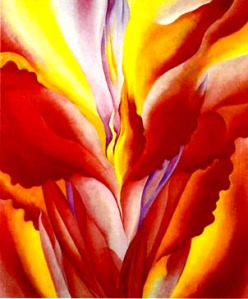I am on a bus from Slough heading for High Wycombe where I will catch another bus to Aylesbury for lunch. I am meeting three school chums who, over 50 years later, are now long-standing friends. HMGov’s concessionary pass has made the omnibus our designated mode of travel.
Frida Kahlo – the artist is the artwork
For the journey I have brought another children’s book from the Artists in their World series. (See Georgia on my mind.) This one is about the Mexican painter Frida Kahlo. Much in the book I already know: her politics, her self-portraits, polio and the bus crash, twice married to Diego Rivera, their sojourn in the States, La Casa Azul.
 Hitherto, I have sensed much of Frida Kahlo is in her paintings but it is a photograph in the book that holds my eyes and launches my thoughts. It is at her only solo exhibition in Mexico (Galeria Arte Contemporaneo, Mexico City, 1953). The seriously ill artist has been brought there and remains confined to her ornate four-poster bed. She is the centre of attention. The artist is the exhibit. The artist is the artwork.
Hitherto, I have sensed much of Frida Kahlo is in her paintings but it is a photograph in the book that holds my eyes and launches my thoughts. It is at her only solo exhibition in Mexico (Galeria Arte Contemporaneo, Mexico City, 1953). The seriously ill artist has been brought there and remains confined to her ornate four-poster bed. She is the centre of attention. The artist is the exhibit. The artist is the artwork.
To what extent can the artist be their work? There have been excreta, blood and skin artworks but these are more Shock Art than Artist Art. Living statues, performance art, living sculptures have at their core presentation over identity. What is the ultimate artwork for the artist? Damien Hirst preserving himself in a tank of formaldehyde? Tracey Emin making My Bedroom a 24/7 reality exhibit as in The Truman Show?
Would I make public my Journal even though it is selectively edited before composition and shies from raw visceral exposure? Those libellous, abhorrent, immoral and criminal components within me. The bus, at least, has reached where it’s going to. Time for lunch.
Carlos Fuentes – the written is the reality
On the journey I have brought another book, short stories by the Mexican novelist Carlos Fuentes. I should have had nachos for lunch given these two books. I aim to return the Fuentes book to High Wycombe library, as I’ll be close to it when changing buses and not near another Bucks CC library for days.
 Disembarking at the bus station from the Aylesbury bus I ignore the 16:30 Slough bus that is on the point of leaving because I have lugged the bulky Carlos Fuentes book all day and am determined to return it. I stroll the 150 metres to High Wycombe library. It is closed. At 16:35? What! A main library is closed on a Monday. How out-in-the-sticks is that?
Disembarking at the bus station from the Aylesbury bus I ignore the 16:30 Slough bus that is on the point of leaving because I have lugged the bulky Carlos Fuentes book all day and am determined to return it. I stroll the 150 metres to High Wycombe library. It is closed. At 16:35? What! A main library is closed on a Monday. How out-in-the-sticks is that?
I stride back to the bus station to learn the next bus to Slough is not until 17:05. I walk back to the library planning to keep walking along London Road until I reach a bus stop just before the expected arrival time there. I reckoned to catch the 17:05 in Loudwater.
At the end of the pedestrian area of the High Street a bus is stuck trying to emerge into the traffic. Blow me if it isn’t the one I’d ignored in the bus station – check my watch – 16 minutes ago. I jog past it to the stop with Carlos bouncing in my knapsack against my spine.
The bus is crowded but I spot an aisle seat next to a slender pale woman. I am aware of her staring at me but I sit down anyway. “Weren’t you at the bus station?” she asks. I am flattered and fearful at the same time. “I was just wondering why you didn’t get on this bus there.”
I explain. She delves in her bag and with a smile shows me her work ID card. I read Bucks CC Library Service, Connie Hull. “The library is open on Sundays from 11 to 5,” she offers, undermining my closed-on-Mondays rant. “It is only open to staff on Mondays.” Connie volunteers to return my book for me the next day and I hand over my burden. She handles it as if a treasure, flicking through inquisitively and begins to read a story.
Exactly four weeks and a day later, a Tuesday, I am in High Wycombe library paying the overdue fine plus the charge for the lost Carlos Fuentes book. The assistant tells me Connie Hull did work in the library, that she was obsessionally devoted to it. She was killed in a bus accident three years ago.
I look at the form I’ve signed for the lost book: Constancia and Other Stories for Virgins by Carlos Fuentes. I replay the opening story through my mind, Constancia, a woman of life extended through another. Somewhere on this journey back from lunch with four friends in Aylesbury I have been diverted into magical realism.





